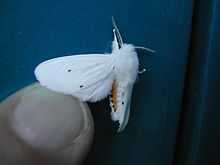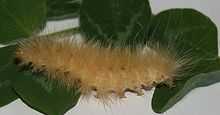Spilosoma virginica
| Spilosoma virginica | |
|---|---|
 | |
 | |
| Conservation status | |
| Not evaluated (IUCN 3.1) | |
| Scientific classification | |
| Kingdom: | Animalia |
| Phylum: | Arthropoda |
| Class: | Insecta |
| Order: | Lepidoptera |
| Family: | Arctiidae |
| Genus: | Spilosoma |
| Species: | S. virginica |
| Binomial name | |
| Spilosoma virginica Fabricius (1798) | |
Spilosoma virginica is a species of moth in the Arctiinae subfamily. As a caterpillar, it is known as the yellow woolly bear or yellow bear caterpillar. As an adult, it is known as the Virginia tiger moth.
Caterpillar life stage
Identification
The caterpillar varies in color, but is typically consistent in its coloration in a single specimen, without odd tufts of different-colored hair or separately colored heads.
Diet
It has a diet of a wide range of low-growing plants, including ground cover like grass and clover. This species tends to have two to three life cycles per year, with one hibernating for the winter in temperate climates.
Adult moth life stage
The adult moth tends to tent its wings over its back, rather than sitting with them spread. It is white with a darker-colored abdomen, but without the obvious, darker eyes of its close cousin the agreeable tiger moth. It is not poisonous, but some people may have an allergic reaction to the bristles on its body.
Reproduction
The female is slightly larger than the male in larva form, and as an adult finds a mate by extruding an organ that emits a pheromone which the male can smell. The male, which unlike the female has the large, feathered antennae characteristic of pheromone-using moths, flies zigzag search patterns, eventually homing in on a female. After mating, he goes off to find other females, while the female stops to lay between 20 and 100 eggs in a single layer on the underside of a leaf. The larvae stay together when very young, but become solitary as they gain size.
See also
| Wikimedia Commons has media related to Spilosoma virginica. |
| Wikispecies has information related to: Spilosoma virginica |
Further reading
- Pankoke, Helga; Bowers, M. Deane; Dobler, Susanne (December 2010). "Influence of iridoid glycoside containing host plants on midgut β-glucosidase activity in a polyphagous caterpillar, Spilosoma virginica Fabricius (Arctiidae)". Journal of Insect Physiology 56 (12): 1907–12. doi:10.1016/j.jinsphys.2010.08.013. PMID 20727899.
- Peterson, Robert K. D.; Higley, Leon G.; Buntin, G. David; Pedigo, Larry P. (January 1993). "Flight Activity and Ovarian Dynamics of the Yellow Woollybear, Spilosoma virginica (F.) (Lepidoptera: Arctiidae), in Iowa". Journal of the Kansas Entomological Society 66 (1): 97–103. JSTOR 25085415.
- Bruner, Lawrence (1892). "The Yellow Bear Moth (Spilosoma virginica Fab.)". In Furnas, Robert W. Annual Report. Nebraska State Board of Agriculture for the Year 1891. p. 245.